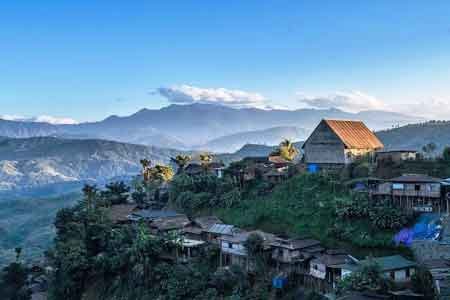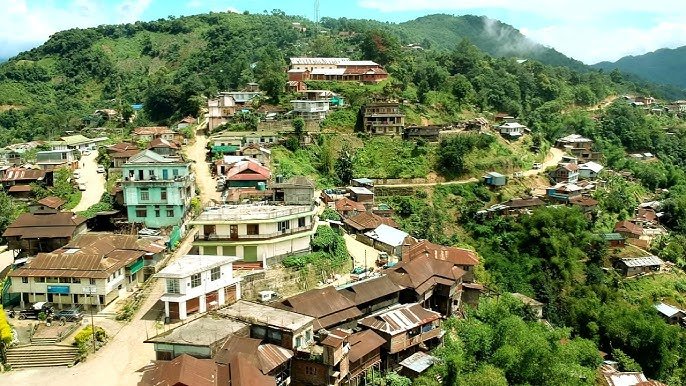Peren, the eleventh and newest district of Nagaland, carved out of the erstwhile Kohima district, is a land of captivating natural beauty and rich cultural heritage. Known as “the Green District of Nagaland” for its dense forests and biodiversity, Peren offers a unique glimpse into the traditions and lifestyle of its indigenous communities.
Origin and History
Peren was declared a full-fledged Revenue District on 24 January 2004. The primary inhabitants of the region, the Zeliangrong people (comprising the Zeme, Liangmai, and Rongmei tribes), trace their origins to Nkuilwangdi in the present-day Senapati district of Manipur.
Historically, the area remained relatively isolated, allowing the Zeliangrong people to preserve their distinct culture and traditions. The British established their presence in the region after consolidating control over Kohima in 1879. Recognizing the need for communication, they constructed a bridle path through the area in 1885, connecting Khonoma to Tening. This path played a role in quelling the freedom movement led by Rani Gaidinliu in the 1930s.
The advent of Christianity had a significant impact on the Zeliangrong community, with the first conversions occurring over a century ago. Today, Christianity is deeply rooted in Peren, with a significant majority of the population identifying as Christian.

Landscape and Biodiversity
Peren’s landscape is characterized by rolling hills, dense sub-tropical forests, and fertile valleys. It forms a part of the Barail Ranges, contributing to its rich biodiversity. The district can be broadly divided into three regions:
The Barail Ranges (Hill Sector): Rugged terrain covered with lush forests.
The Jalukie Valley (Plain Sector): Known as the “Rice Bowl of Nagaland” for its extensive paddy fields.
The Intangki Forest (Reserved Forest): A significant biodiversity hotspot and home to the Ntangki National Park.
The district boasts a high concentration of flora and fauna, including various species of orchids, rhododendrons, medicinal plants, and wildlife such as wild buffaloes (mithun), hoolock gibbons, tigers, sloth bears, and a variety of birds.
Population and Tribes
As per the 2011 census, the population of Peren district was 95,219. The major indigenous tribes inhabiting the district are the Zeme, Liangmai, and Kuki. The Rongmei tribe also has a significant presence. Each of these tribes has its own distinct customs, traditions, festivals, and languages.
The languages primarily spoken in Peren are Zeme, Liangmai, Kuki, and Rongmei. Nagamese, a creole language, is also widely understood, and English serves as the official language of Nagaland.

Heritage and Culture
Peren is known for the rich cultural heritage of its tribes. Traditionally, the people were skilled in dance, music, arts, and crafts. Each tribe has its own vibrant festivals that showcase their unique traditions, songs, dances, and rituals. Some prominent festivals include:
Hega Festival: A significant post-harvest festival of the Zeme and Liangmai tribes.
Chega-Gadi: Another important festival of the Zeme tribe.
Langsimngyi: A festival celebrated by the Liangmai tribe.
Mimkut Festival, Chapphou Kuut, and Chavang Kuut: Major festivals of the Kuki tribe.
Gaan-Ngai: A significant festival of the Rongmei tribe.
The district also holds historical significance with remnants of ancient monoliths and stone carvings found around Mt. Paona, reflecting the rich history and craftsmanship of the local communities.
Infrastructure Development
While historically isolated, Peren is gradually witnessing infrastructure development. Road connectivity is improving, linking the district to major centers like Dimapur (approximately 95 km) and Kohima (approximately 100 km via K-L Road).

Current Infrastructure Projects:
National Highway 129A: A significant project underway to improve connectivity between Peren and Dimapur. Facilitation meetings have been held in February 2025 for the Peren town portion of Package-1. This project aims to provide a good quality two-lane highway in Peren town (2.8 km stretch) with a significant investment, including compensation for affected landowners. The expected completion time for this portion is 18 months from the appointed date. The successful implementation of NH-129A is expected to significantly boost the socio-economic development of the region.
Peren is widely known as “the Green District of Nagaland” due to its extensive forest cover and biodiversity. It is also known for:
The Zeliangrong tribes: Their unique culture, traditions, and vibrant festivals.
Ntangki National Park (Intanki): A significant wildlife sanctuary home to diverse flora and fauna.
Jalukie Valley: The “Rice Bowl of Nagaland,” contributing significantly to the state’s agricultural output.
Mt. Paona: The third highest peak in Nagaland, offering panoramic views and trekking opportunities.
The origin of Naga King Chili (Chaibe Rachi): This popular chili variety is believed to have originated in Peren district.
Nagaland Solar Mission Launch: Chief Minister Neiphiu Rio recently launched the Nagaland Solar Mission, encouraging the installation of residential rooftop solar systems in convergence with the Prime Minister Surya Ghar Yojana. The state government is providing an additional subsidy of up to ₹50,000 for systems up to 3 kW to promote green energy adoption in districts like Peren.
NH-129A Project Progress: As mentioned earlier, significant progress is being made on the NH-129A project, which is expected to transform road infrastructure in Peren town.
Tourism Potential: Peren is recognized for its potential in cultural and eco-tourism, with its diverse ethnic groups, festivals, and natural landscapes attracting increasing attention.
Currently, there are no specific major upcoming events listed for Peren district on the official government website. However, the region’s tribal festivals are celebrated annually according to their traditional calendars. For the most up-to-date information on local events, it is advisable to check with local authorities and community organizations closer to specific dates.
Tourism in Peren
Peren offers a unique and off-the-beaten-path tourism experience for nature and culture enthusiasts. Key attractions include:
Ntangki National Park: For wildlife viewing and exploring pristine forests.
Mt. Paona: For trekking and panoramic views of the surrounding valleys.
Benreu Village: A tourist village offering a glimpse into local life and nearby wildlife.
Mt. Kisa: Another significant peak with natural beauty.
Caves at Puilwa Village: Offering opportunities for exploration.
Peren’s serene landscapes, rich cultural embroidery, and warm hospitality make it an increasingly attractive destination for those seeking an authentic Nagaland experience. With improving infrastructure, the district is poised to unlock its full potential as a significant tourism hub in the state.

